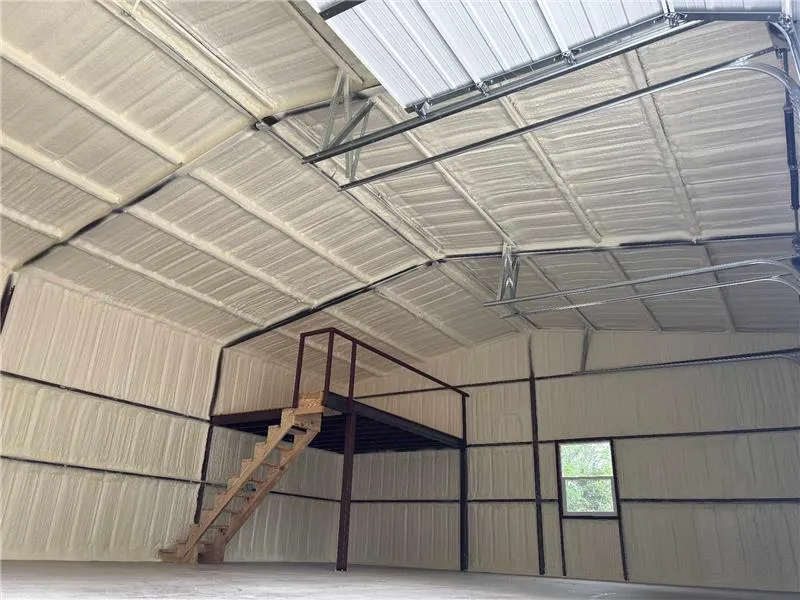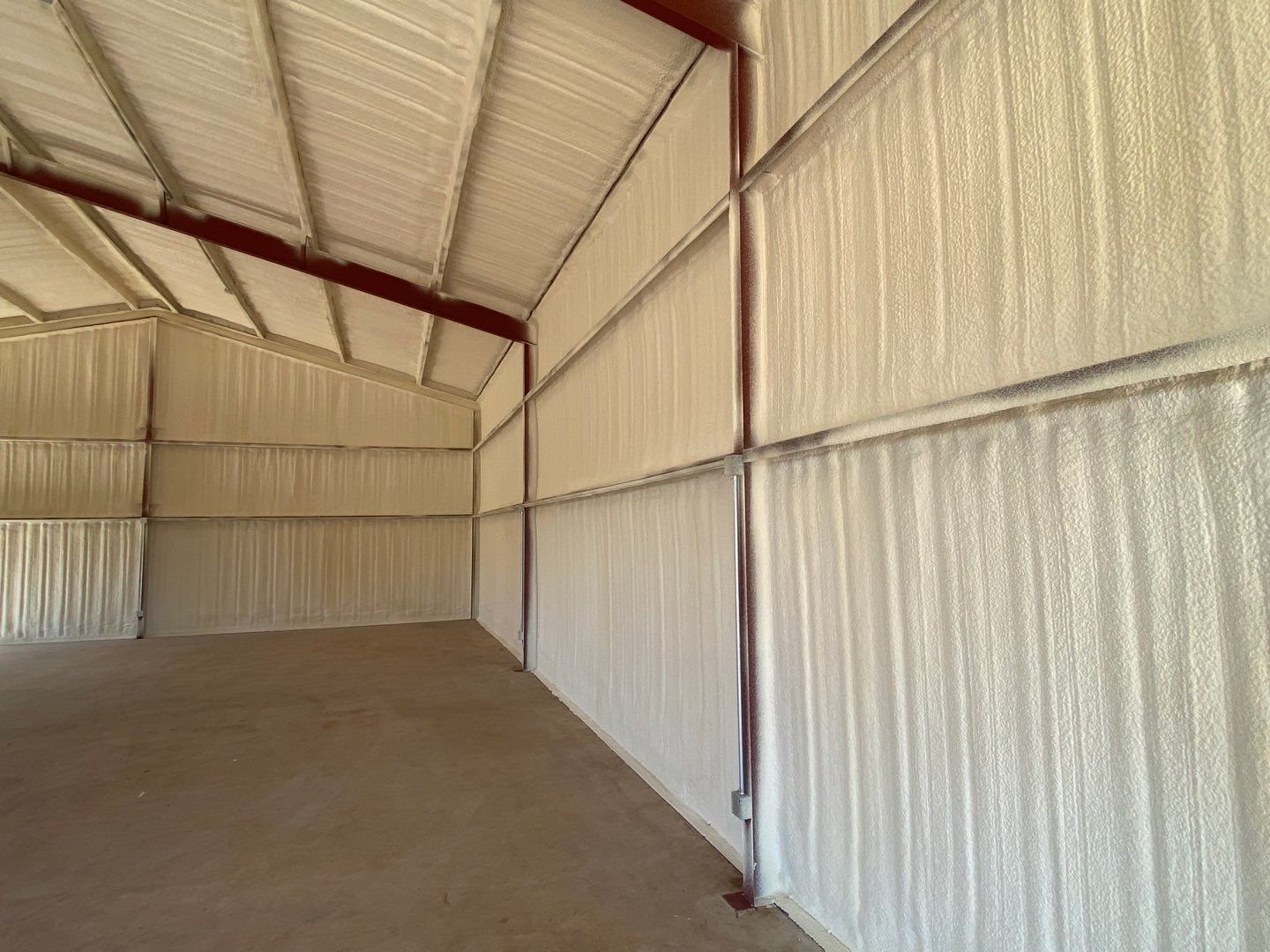Yes, closed-cell commercial insulation absolutely adds significant structural strength to a building. Unlike any other type of insulation, closed-cell spray polyurethane foam (SPF) acts as a high-strength structural adhesive. As it cures, it forms a powerful bond with the building materials it’s applied to, essentially gluing the studs, sheathing, and other components together into a single, solid unit. This process dramatically increases a building assembly’s resistance to racking forces, which are the shearing pressures caused by high winds or seismic events.
While its primary function is to provide a high R-value and an air and vapor barrier, this secondary structural benefit is a major reason why architects and engineers specify closed-cell foam for commercial projects. This is especially true for buildings with large, open spans or steel frames. Drawing on industry testing and the practical experience of commercial insulation contractors, this guide explains exactly how this material enhances a building’s strength and durability.
How Insulation Becomes a Structural Component
The key to understanding this benefit lies in the transformation of the material itself. Closed-cell foam starts as two separate liquid components. When mixed and sprayed, they undergo a rapid chemical reaction, expanding and curing into a dense, rigid, and lightweight solid.
It’s this cured state that gives it its strength. The foam has a high compressive strength and, more importantly, it adheres tenaciously to almost any substrate. This is fundamentally different from traditional insulation methods:
- Fiberglass or Mineral Wool Batts: These are simply placed in a cavity and offer zero structural value.
- Rigid Foam Boards: While strong, they are installed as separate panels with seams, and they do not bond the framing members together.
Closed-cell SPF, by contrast, fuses the entire assembly. It distributes loads across the whole surface of the wall or roof deck, rather than concentrating them on individual fasteners like nails or screws. This creates a composite structure that is far stronger than the sum of its parts.

The Science Behind Increased Racking Strength
The most quantifiable structural benefit of closed-cell foam is its impact on racking strength. This is a measure of a wall’s ability to resist being pushed out of square by lateral forces, such as strong winds.
Independent testing conducted by organizations like the National Association of Home Builders (NAHB) Research Center has consistently shown that applying closed-cell spray foam to a standard wall assembly can increase its racking strength by anywhere from 75% to over 300%. The reason for this dramatic improvement is that the foam turns the wall from a simple frame with sheathing into a stressed-skin panel, similar to those used in aircraft manufacturing. The rigid foam core prevents the individual components from shifting, flexing, or buckling under pressure.
In some new construction designs, the proven structural contribution of closed-cell foam can allow engineers to reduce the amount of traditional bracing required, which can help offset material costs and simplify the framing process.
Key Applications for Structural Reinforcement
While the structural benefits apply to any building, they are particularly valuable in certain types of commercial construction.
Metal Buildings
Steel-framed buildings are incredibly common for warehouses, manufacturing facilities, and agricultural storage. The strength of these buildings comes from their steel skeleton, but the large metal wall and roof panels can be susceptible to flexing, vibration, and damage from wind. Applying closed-cell spray foam to the interior of these panels locks them rigidly to the steel purlins and girts. This makes the entire building envelope stiffer, stronger, and far more resistant to wind load. It also eliminates the annoying “chattering” sound that can occur in high winds.
Commercial Roof Decks
Wind uplift is a major cause of roof failure in severe weather. When high winds pass over a roof, they create a pressure differential that can literally pull the sheathing off the rafters or trusses. By applying closed-cell foam to the underside of the roof deck, you are essentially gluing the sheathing to the entire framing system. This creates a powerful, continuous bond that is far stronger than nails or staples alone, dramatically increasing the roof’s resistance to wind uplift.
Moisture Protection and Long-Term Durability
Structural strength isn’t just about resisting a single event like a storm; it’s also about long-term durability. A building’s greatest enemy over time is moisture. Water intrusion leads to the corrosion of metal fasteners, the rusting of steel components, and the rot and decay of wood framing, all of which compromise the building’s structural integrity.
Closed-cell spray foam is a certified vapor barrier. It is impermeable to water and moisture vapor. When applied as a continuous layer, it creates a seamless barrier that protects the building’s structural components from moisture damage. By keeping the structure dry, it preserves its designed strength for the entire life of the building. This is a form of passive strengthening that is critical for long-term resilience.

Comparing the Structural Impact of Insulation
| Feature | Closed-Cell Spray Foam | Rigid Foam Board | Fiberglass Batts |
|---|---|---|---|
| Adhesion to Structure | Excellent; bonds components together | None; mechanically fastened | None; friction fit |
| Racking Strength | Significantly increases (up to 300%) | Minor increase | None |
| Wind Uplift Resistance | High; bonds sheathing to frame | Minimal | None |
| Moisture Protection | Excellent; acts as a vapor barrier | Good; but has seams that can leak | Poor; can trap moisture against structure |
| Overall Durability | Enhances the longevity of the structure | Provides a thermal break | No contribution |
Things to Consider Before Making a Decision
While the structural benefits are significant, it’s important to have a clear understanding of the material’s role.
Foam is a Supplement, Not a Substitute
Closed-cell spray foam should be viewed as a way to enhance a building’s engineered design, not as a replacement for proper structural engineering. It makes a well-designed structure even stronger and more resilient. It cannot be used to fix a building that is already structurally unsound. Any existing rot, rust, or other structural deficiencies must be repaired before the foam is applied.
The Critical Role of the Installer
The structural benefits are only achieved when the foam is installed correctly by a certified professional. The foam must be applied at the correct thickness and achieve a full, continuous bond with the substrate. This requires sophisticated equipment and a deep understanding of the chemical process, especially in the variable conditions of a commercial job site.
For projects involving unique structural designs or historic retrofits, the insulation contractor should work in close collaboration with the project’s structural engineer to ensure the foam is being used in a way that complements the overall design.
Questions People Ask About Structural Foam
Does open-cell foam also add strength?
No. Open-cell foam is soft, light, and flexible. While it is an excellent insulator and air barrier, it does not have the density or rigidity to provide a significant structural benefit.
Can spray foam be used to strengthen a foundation?
When applied to the interior of a concrete foundation wall, closed-cell foam adds some stability and helps seal minor cracks. However, its primary benefit in this application is providing a continuous insulation and vapor barrier, not serving as a primary structural reinforcement.
Is there an extra cost for the structural benefit?
No. The structural reinforcement is an inherent physical property of closed-cell foam. You get the benefit as part of the standard installation.
How does the foam’s strength hold up over time?
Once cured, closed-cell foam is a very stable thermoset plastic. It does not shrink, settle, or degrade over time. The structural enhancement it provides is permanent and will last for the life of the building.
Can it be used on both wood-framed and steel-framed buildings?
Yes, it adheres extremely well to both wood and steel, making it a versatile solution for enhancing the strength of virtually any type of commercial building frame.
A Smart Investment in a Stronger Building
Closed-cell spray foam is unique in the world of insulation. It is the only product that serves as a high-performance insulator, an air barrier, a vapor barrier, and a structural reinforcement all in one application. For business owners, developers, and property managers, choosing closed-cell foam is a strategic investment that pays dividends not only in lower energy bills but also in a stronger, more durable, and more resilient building.
Consult With a Commercial Insulation Specialist
To fully understand how closed-cell spray foam can be integrated into your commercial project, a consultation with an experienced contractor is essential. A professional can review your building’s plans, discuss your specific needs, and explain how the structural properties of foam can benefit your design. For businesses looking for this level of expertise, the team at LMC Insulation has a deep understanding of commercial and industrial applications. Their specialists can be reached for a project evaluation at [email protected] or by phone at (479) 351-6175.
Reviewer: Samuel Harris has worked across various roles in spray foam insulation over 11 years. His review focused on how businesses can better present their services to both new and returning clients.